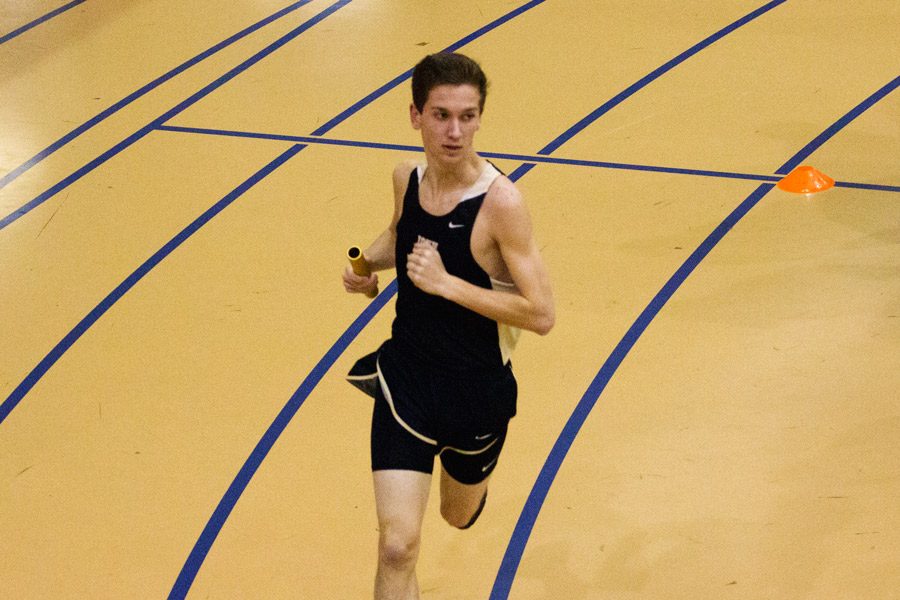Off the beaten track
The rough and tough indoor track and field team practices through rain, snow, and mud to prepare for their meets
After days of training through mud and slush, junior Evan Tridone eases his way around the bend in his 800 m relay in the MIAA Meet at Loyola Blakefield on Nov. 8. Even though the team finished 10th out of 12 teams, many of them placed individually in their events.
Huddled in a thin sweatshirt, senior Iain Olsen trudges out to the cold track. Bracing himself against the wind, he tries to warm up his frozen muscles with a lap around the track, but he finds no relief. He runs two, three, four more laps just to warm himself up to start practice.
Olsen is a member of the relatively small indoor track and field team. With little resources and critically, no indoor track, the team finds themselves in the painful position of practicing outdoors in the middle of the winter, regardless of weather conditions.
Distance runners are mostly affected by these conditions, whereas some sprint workouts are conducted inside if there is inclement weather. “We run in the snow, pouring rain, sleet, hail, and even when the track is covered in a foot of snow. It makes running really challenging, especially on speed days,” senior distance runner Adria Pirozzi said.
Despite these challenges, there is anticipation for the women’s team to do well this season. Sprint and field events coach Robert Torres noted his team’s talent and passion, despite its size.
“The girls will be a quality team. We don’t have enough to win the conference, but we have enough talent to score in a lot of events,” he said.
Pirozzi agreed with Torres that while the team is small, individual athletes will do well in the championships this year. “We lost a lot of our super sprinters last year so it will be difficult to place this year, [but] Chika Chuku will definitely be a stand-out this season. She was new last year and is already a top scorer,” she said.
With the additional help of senior sprinters Abby Hormes and Charlotte Haggerty and junior sprinter Ashlee Kothenbeutel filling in some holes, junior distance runner Laura Amrhein believes that the team should perform well. “The team should do pretty decent. Our sprinters look very good from what I have seen, and so do our pole-vaulters and high jumpers,” she said.
Amrhein also acknowledged her fellow distance runner, Pirozzi, “who will hopefully lead the team to victory.” Pirozzi has been putting in extra hours running every day, even on weekends and holidays, to prepare for her upcoming running seasons.
“My dad always told me that there’s always somebody out there who’s pushing themselves harder. If you want to perform well, you have to make sure that you’re giving it your best effort, no matter the circumstance,” Pirozzi said.
On the men’s side, distance coach Michael Monaghan believes the main goal for this season is to improve. “If we have halfway decent weather and [our] athletes put forth a concerted effort, improvement is almost guaranteed,” he said.
While the team practices hard every day, the men’s team is only able to field two varsity athletes, as varsity is determined based on time. “We haven’t been this light at the varsity level since we started indoor track back in 2002,” Monaghan said.
The two men’s varsity athletes are junior David Pajerowski and senior Steven Kutcher, both of whom pole-vault. Pajerowski also participates in the 55m hurdles, the 55m, and the 300m. “I train by practicing every day and pushing myself to the limit,” Pajerowski said.
Olsen believes the team has the potential to perform well individually, but he also believes it is going to be hard as a team. “I think we will do alright. I don’t think we have that stellar of a team. We are really focused on just trying to place,” he said.
Junior distance runner Connor Kiss also believes that the team has potential, but with the team’s small size, it is going to be hard to compete. Kiss noted that competing against other big teams can be discouraging, “you realize that you are [just as] good and that you are able to compete and keep up with them. I think we can accomplish just as much as they can.”
In hopes of improving the team’s chances, the athletic department, facilities, and administration are currently talking about improving the outdoor track. Monaghan believes that the track “at the very least needs to be resurfaced as many of the inner lanes are degrading to the point of being tripping hazards, especially in the sprint events. The long jump runway is probably worse than the track.”
The main obstacle to refurbishing the track is the cost of the project. “The fix is expensive,” Monaghan said. “The facilities department has received a few bids to resurface or replace the track, [but] I believe the cost is more than we can afford.”
With the upcoming outdoor track and field season approaching, and looking to future seasons, Monaghan hopes to still be able to hold competitions at JC. “We host many meets for the MIAA and the IAAM, including the outdoor B conference championship. It would be a shame if for safety reasons, we stopped hosting these events,” he said.
Despite the team’s size, this does not mean that they lack the heart or the drive to win. The team looks forward to an exciting season with many new players. “Indoor is a quirky beast, we never seem to be able to cover all the events in depth … [but] we always try to progress a bit each week,” Monaghan said.
Taylor Bynion is a Copy Editor and Emily Stancliff is a Sports Editor for The Patriot and jcpatriot.com.



